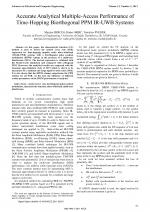| 2/2011 - 10 |
Accurate Analytical Multiple-Access Performance of Time-Hopping Biorthogonal PPM IR-UWB SystemsHERCEG, M. |
| View the paper record and citations in |
| Click to see author's profile in |
| Download PDF |
Author keywords
symbol error rate, biorthogonal pulse position modulation, characteristic function, ultra-wideband, multi-user interference
References keywords
modulation(7), systems(6), multiple(6), communications(6), time(5), hopping(5), access(5), ultra(4), pulse(4)
Blue keywords are present in both the references section and the paper title.
About this article
Date of Publication: 2011-05-30
Volume 11, Issue 2, Year 2011, On page(s): 63 - 66
ISSN: 1582-7445, e-ISSN: 1844-7600
Digital Object Identifier: 10.4316/AECE.2011.02010
Web of Science Accession Number: 000293840500010
SCOPUS ID: 79958819490
Abstract
In this paper, the characteristic function (CF) method is used to derive the symbol error rate (SER) expression for time-hopping impulse radio ultra-wideband (TH-IR-UWB) systems with a biorthogonal pulse position modulation (BPPM) scheme in the presence of a multi-user interference (MUI). The derived expression is validated with the Monte-Carlo simulation and compared with orthogonal PPM. Moreover, the analytical results are compared with the Gaussian approximation (GA) of MUI which is shown to be inaccurate for a medium and large signal-to-noise ratio (SNR). It is also shown that the BPPM scheme outperforms the PPM scheme for all SNR. At the end, the influence of different system parameters on the BPPM performance is analyzed. |
| References | | | Cited By «-- Click to see who has cited this paper |
| [1] R. A. Scholtz, "Multiple access with time-hopping impulse modulation", Proc. IEEE Military Commun. Conf., pp. 11-14, October. 1993.
[2] T. N. Durnea, N. D. Alexandru, "Calculus of the Power Spectral Density of Ultra Wide Band Pulse Position Modulation Signals Coded with Totally Flipped Code," Advances in Electrical and Computer Engineering, vol. 9, no. 1, pp. 16-21, 2009. [CrossRef] [Full Text] [Web of Science Times Cited 2] [3] M. Herceg, T. vedek, and T. Matiæ, "Pulse Interval Modulation for Ultra-High Speed IR-UWB Communications Systems," EURASIP Journal on Advances in Signal Processing, vol. 2010, Article ID 658451, 8 pages, 2010. [CrossRef] [Web of Science Times Cited 6] [4] H. Zhang, W. Li, and T. A. Gulliver, "Pulse Position Amplitude Modulation for Time-Hopping Multiple-Access UWB Communications", IEEE Trans. on Comm., vol. 53, no. 8, August 2005. [CrossRef] [Web of Science Times Cited 33] [5] S. Majhi and A. S. Madhukumar, "Combining OOK with PSM Modulation for TH-UWB Radio Systems: A Performance Analysis", EURASIP Journal on Wireless Comm. and Networking, vol. 2008. [6] M. Herceg, T. Matic and T. Svedek, "Performances of hybrid Amplitude Shape Modulation for UWB communications systems over AWGN channel in the single and multi-user environment", Radioengineering Journal, September 2009. [7] M. Z. Win and R. A. Scholtz, "Ultra-wide bandwidth time-hopping spread-spectrum impulse radio for wireless multiple-access communications," IEEE Trans. Commun., vol. 48, pp. 679-689, 2000. [CrossRef] [Web of Science Times Cited 1739] [8] G. Durisi and G. Romano, "On the validity of Gaussian approximation to characterize the multiuser capacity of UWB TH PPM," in Proc. IEEE Conf. Ultra Wide-band Systems and Technologies, Baltimore, USA, May 2002, pp. 157-161. [CrossRef] [9] H. Bo and N. C. Beaulieu, "Accurate evaluation of multiple-access performance in TH-PPM and TH-BPSK UWB systems," IEEE Trans. Commun., vol. 52, no. 10, pp. 1758-1766, 2004. [CrossRef] [Web of Science Times Cited 132] [10] Q. F. Zhou and F. C. M. Lau, "Analytical Performance of M-ary Time-Hopping Orthogonal PPM UWB Systems under Multiple Acces Interference", IEEE Trans. Commun., vol. 56, no. 11, pp. 1780-1784, 2008. [CrossRef] [Web of Science Times Cited 11] [11] H. Zhang, and T. A. Gulliver, "Biorthogonal Pulse Position Modulation for Time-Hopping Multiple-Access UWB Communications", IEEE Trans. On Wireless Comm., vol. 4, no. 3, May 2005. [CrossRef] [Web of Science Times Cited 51] [12] J. G. Proakis, "Digital Communications", 4th ed., New York: McGraw-Hill, 2001 Web of Science® Citations for all references: 1,974 TCR SCOPUS® Citations for all references: 0 Web of Science® Average Citations per reference: 152 ACR SCOPUS® Average Citations per reference: 0 TCR = Total Citations for References / ACR = Average Citations per Reference We introduced in 2010 - for the first time in scientific publishing, the term "References Weight", as a quantitative indication of the quality ... Read more Citations for references updated on 2024-04-16 06:45 in 48 seconds. Note1: Web of Science® is a registered trademark of Clarivate Analytics. Note2: SCOPUS® is a registered trademark of Elsevier B.V. Disclaimer: All queries to the respective databases were made by using the DOI record of every reference (where available). Due to technical problems beyond our control, the information is not always accurate. Please use the CrossRef link to visit the respective publisher site. |
Faculty of Electrical Engineering and Computer Science
Stefan cel Mare University of Suceava, Romania
All rights reserved: Advances in Electrical and Computer Engineering is a registered trademark of the Stefan cel Mare University of Suceava. No part of this publication may be reproduced, stored in a retrieval system, photocopied, recorded or archived, without the written permission from the Editor. When authors submit their papers for publication, they agree that the copyright for their article be transferred to the Faculty of Electrical Engineering and Computer Science, Stefan cel Mare University of Suceava, Romania, if and only if the articles are accepted for publication. The copyright covers the exclusive rights to reproduce and distribute the article, including reprints and translations.
Permission for other use: The copyright owner's consent does not extend to copying for general distribution, for promotion, for creating new works, or for resale. Specific written permission must be obtained from the Editor for such copying. Direct linking to files hosted on this website is strictly prohibited.
Disclaimer: Whilst every effort is made by the publishers and editorial board to see that no inaccurate or misleading data, opinions or statements appear in this journal, they wish to make it clear that all information and opinions formulated in the articles, as well as linguistic accuracy, are the sole responsibility of the author.





